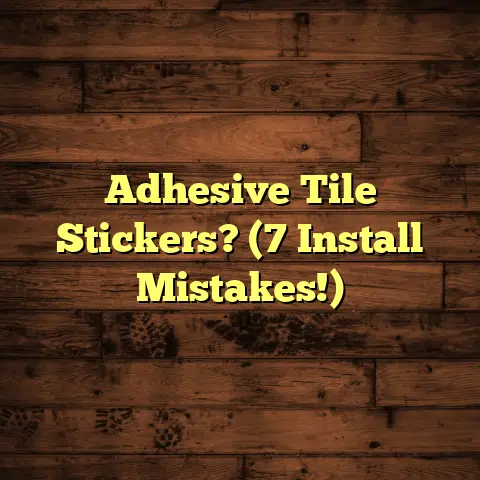Peel & Stick Tiles Won’t Stick? (1 Pro Trick!)
Ever get that excited feeling when you’re about to transform a room?
You’ve got your peel and stick tiles, envisioning a beautiful new floor,
a fresh backsplash, or maybe even an accent wall.
You meticulously lay out the first few tiles, feeling that satisfaction of a DIY project coming together.
But then… wham!
They just won’t stick.
The corners curl up, bubbles form underneath,
and that initial excitement turns into a frustrating mess.
Trust me, I’ve been there.
As a flooring contractor with years under my belt,
I’ve seen this scenario play out more times than I can count.
The confusion, the disappointment, the burning question: “What went wrong?”
Well, you’re not alone, and I’m here to tell you, there’s hope!
I’m going to let you in on a pro trick that can salvage your project
and get those stubborn tiles to finally stick.
Section 1: Understanding Peel & Stick Tiles
So, what are peel and stick tiles anyway?
Basically, they’re a thin layer of vinyl or sometimes even
a composite material, with a pre-applied adhesive backing.
Think of them as the DIY-friendly cousin of traditional tile.
You peel off the backing, stick them to the floor, and bam – instant
(or at least, supposedly instant) transformation.
These tiles are designed to be super easy to install, which makes them a popular choice for homeowners looking to save money on professional installation.
They’re also cost-effective, often significantly cheaper than
traditional ceramic or stone tiles.
Plus, they come in a huge
range of styles, colors, and patterns, making them incredibly versatile.
According to a 2023 report by Grand View Research, the global
vinyl flooring market, which includes peel and stick tiles,
was valued at $39.55 billion USD.
(https://www.grandviewresearch.com/industry-analysis/vinyl-flooring-market)
That’s a lot of peel and stick action!
The appeal is clear.
They’re quick, affordable, and
relatively mess-free.
But the key word here is relatively.
Because as many of us have learned the hard way,
they don’t always live up to the hype.
Section 2: The Problems with Adhesion
Here’s the million-dollar question: Why do peel and stick
tiles sometimes fail to stick?
It all comes down to adhesion –
the ability of the adhesive to properly bond to the surface.
And there are a few key culprits that can sabotage that bond.
Surface Preparation: The Foundation of Success
This is the most crucial step, and where most people go wrong.
Think of it this way: you wouldn’t build a house on a shaky
foundation, right?
The same goes for peel and stick tiles.
The surface needs to be clean, dry, and smooth.
Clean: Any dirt, dust, grease, or old adhesive residue will prevent the tile from properly adhering.
I always recommend thoroughly cleaning the surface with a degreaser.Dry: Moisture is the enemy of adhesive.
Make sure the surface is completely dry before you even think about peeling off that backing.Smooth: Any bumps, cracks, or imperfections will create air pockets and weaken the bond.
You might need to use a leveling compound to create a perfectly smooth surface.
Here’s a quick rundown of common surface types and their compatibility with peel and stick tiles:
Temperature and Humidity: The Unseen Saboteurs
Environmental factors play a bigger role than you might think.
Adhesive works best within a specific temperature range,
usually between 65°F and 85°F (18°C and 29°C).
Too cold, and the adhesive becomes stiff and less tacky.
Too hot, and it can become too soft and lose its grip.
Humidity also affects adhesion.
High humidity can prevent
the adhesive from properly curing, leading to a weak bond.
Imagine trying to install tiles on a sweltering summer afternoon
with the windows open.
The heat and humidity will work against you,
making it much harder for the tiles to stick properly.
Tile Quality: Not All Tiles Are Created Equal
This is where things get interesting, and where the “pro trick”
comes into play.
The quality of the adhesive on peel and stick
tiles can vary significantly between brands and even between
different product lines from the same brand.
Some tiles use a high-quality adhesive that bonds strongly
and reliably.
Others… well, let’s just say they’re not quite
as sticky.
This is often where people run into problems.
I’ve seen cases where homeowners purchased seemingly identical tiles from two different stores, only to find that one brand stuck perfectly while the other peeled up within days.
This difference in adhesive quality is often reflected in
the price.
Cheaper tiles often use cheaper adhesives,
which can lead to adhesion problems down the road.
Section 3: Troubleshooting Common Issues
Okay, so you’ve installed your peel and stick tiles, and
they’re not sticking.
Don’t panic!
Let’s troubleshoot some
common issues and see if we can get things back on track.
-
Tiles lifting at the edges:
- Potential Causes: Insufficient surface preparation, uneven surface, low-quality adhesive, temperature fluctuations.
- Immediate Steps: Clean the area around the lifting edge, apply pressure to re-adhere the tile, and consider using a heat gun (on a low setting) to soften the adhesive.
Bubbles forming under the surface:
- Potential Causes: Trapped air, uneven surface, moisture, improper installation technique.
- Immediate Steps: Use a utility knife to carefully
puncture the bubble, then press down firmly to release
the trapped air.
Consider using a seam roller to smooth out the surface.
-
Inconsistent adhesion in different areas:
- Potential Causes: Variations in surface preparation, temperature fluctuations, inconsistent adhesive quality, uneven pressure during installation.
- Immediate Steps: Re-clean and dry the areas with poor adhesion, apply additional pressure during installation, and consider using a primer to improve adhesion.
-
Tiles sliding or shifting:
- Potential Causes: Insufficient adhesive strength, slippery surface, heavy foot traffic, temperature changes.
- Immediate Steps: Ensure the surface is properly prepared and consider using a stronger adhesive or double-sided tape for added security.
Remember, you’re not alone in this struggle!
Peel and stick tiles can be finicky, but with a little
troubleshooting, you can often salvage the situation.
Section 4: The Pro Trick Revealed
Alright, here’s the moment you’ve been waiting for.
The pro trick that can turn your peel and stick tile nightmare
into a DIY dream.
It’s surprisingly simple, but incredibly effective.
The Pro Trick: Use a Primer!
I know, it sounds basic, but hear me out.
Most people skip this step entirely, assuming that the
pre-applied adhesive is enough.
But as we’ve already discussed,
that’s not always the case.
A primer is a liquid bonding agent that you apply to the
surface before installing the tiles.
It creates a
stronger, more reliable bond between the adhesive and the surface,
dramatically improving adhesion.
I like to use a high-quality acrylic latex primer.
It’s relatively inexpensive, easy to apply, and works well
with most peel and stick tiles.
Here’s how to do it:
Preparation:
- Make sure the surface is clean, dry, and smooth,
as we discussed earlier.
This is non-negotiable! - Lightly sand the surface to create a slightly rough texture.
This will help the primer adhere better. - Wipe away any dust or debris.
- Make sure the surface is clean, dry, and smooth,
as we discussed earlier.
Application:
- Apply a thin, even coat of primer to the surface using a brush or roller.
- Follow the manufacturer’s instructions for drying time.
This is crucial!
Don’t rush it.
Typically, it takes about 30 minutes to an hour.
Results:
- Once the primer is completely dry, you’re ready to install your peel and stick tiles.
- You’ll immediately notice a difference in how well the
tiles adhere.
They’ll stick more firmly and reliably, reducing the risk of lifting, bubbling, or shifting.
Why does this work? The primer essentially creates a
“bridge” between the surface and the adhesive.
It fills in
any microscopic imperfections, creating a smoother, more
uniform surface for the adhesive to bond to.
It also increases the surface area for adhesion, providing a stronger, more durable bond.
Trust me, this simple step can make all the difference between a successful DIY project and a frustrating disaster.
Section 5: Real-Life Success Stories
I’ve seen this trick work wonders for countless homeowners.
Here are a few real-life examples:
Sarah, the Bathroom Backsplash Beginner: Sarah was attempting to install a peel and stick backsplash in her bathroom.
Despite following all the instructions, the tiles kept peeling off around the edges.
After applying a coat of primer, the tiles adhered perfectly and her backsplash looks amazing.Mark, the Basement Floor Fixer: Mark was trying to install peel and stick tiles in his basement, but the concrete floor was too porous.
The tiles wouldn’t stick, and he was ready to give up.
I recommended sealing the concrete and then applying a primer.
The tiles stuck like glue, and his basement floor looks fantastic.
These are just a couple of examples, but I’ve seen this
trick work in countless situations.
It’s a simple, affordable,
and effective way to improve the adhesion of peel and stick tiles.
Conclusion: The Path Forward
Remember that homeowner we talked about at the beginning, the one filled with excitement and anticipation, only to be met with frustration?
Well, now they know the secret.
They know that with the
right preparation and the help of a simple primer, they
can overcome their flooring challenges and create the beautiful
space they’ve always dreamed of.
Peel and stick tiles can be a great option for DIY projects,
but they’re not always as straightforward as they seem.
By understanding the potential problems and using the right
techniques, you can increase your chances of success.
So, go ahead, embrace the DIY spirit!
Don’t let a few stubborn tiles discourage you.
You now have the knowledge and the tools to overcome any
flooring challenges that come your way.





